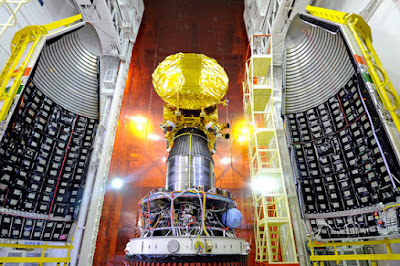5 years ago, the Indian Space Research Organisation's Mangalyaan entered the Martian orbit, thus making India: the first country to achieve this feat in the first attempt. Mars Orbiter Mission (fondly known as MOM) was India's first interplanetary mission. With government approval in August 2012, launch in November 2013 and Mars Orbiter Insertion (MOI) in September 2014; the mission was completed in record time. To achieve this feat, ISRO overcame a number of challenges.
The Launch
 |
| PSLV C-25 Lift Off: Courtesy ISRO |
The MOM spacecraft was launched onboard PSLV C-25 on 5th November 2013. PSLV is the workhorse of ISRO hence it was chosen to launch the spacecraft. This meant placing the vehicle in an orbit around Earth and then subsequently increasing the apogee (highest point of the orbit) in various manoeuvres followed by Trans Mars Injection which placed the Mangalyaan on a 300-day journey to Mars.
To achieve the required parameters for Trans Mars Injection the PSLV C-25 had to perform differently than regular PSLV missions. The fourth stage of the rocket ignited after a long coasting time. To give you an idea, a regular flight takes about 1200 seconds, PSLC C-25 had a flight duration of 2530 seconds. All this meant that by the time the fourth stage ignited, the rocket would be far away from the communication ground segment in India.
To overcome this challenge, two ship-borne tracking terminals were deployed in the Pacific ocean.
Power Subsystem
Mangalyaan had to survive the conditions of a near-Earth Orbit, followed by a heliocentric orbit and finally a Martian orbit. This meant different temperature conditions as well as different solar flux. A single solar array had to be designed which could power the spacecraft with varying flux of 1380 W/m2 in near-Earth to 590 W/m2 in Martian orbit. Moreover, the solar array must generate full power in operating temperatures of +65 ℃ to -20 ℃.
There were many other challenges associated with this mission, all were overcome within one year to launch in the nearest launch window to Mars. If ISRO missed this launch window next one would have come after nearly 2.5 years. The then chairman of ISRO: Dr K. Radhakrishnan states a few of the reasons for achieving this feat:
Communications Subsystem
The communications had to be maintained for four segments, Earth-based phase, cruise phase, MOI phase and Mars Orbit phase. The maximum range for communications was 374 million km (during MOI). To achieve this, precise tracking of the spacecraft is needed. ISRO tracked orbiter with 2m in position, 1mm/s in velocity and 0.4 nanosecond angle precision. This was done using Doppler and ranging methods.
 |
| First Full Disk Image of Mars taken by MOM |
Propulsion Subsystem
The Liquid Engine of 440 N thrust was isolated after the geocentric phase and had to be restarted after 300 days of cruise with its Flow Control Valves (FCV) seats in wetted condition. Extensive ground tests were conducted to ensure this restart burn successfully places MOM into the Martian orbit on 24th September 2019.
 |
| MOM onboard the PSLV Stage 4 |
- Thorough Feasibility Study Leading to Robust Mission Planning
- Resolve to Contribute Might for National Pride
- Learning from Others' Failures
- Rigorous Execution
- Team Preparedness for Contingencies
In all, the Mangalyaan mission pushed ISRO into the limelight for both the scientific community and the general Indian public. China referred to the mission as "Pride of Asia". The Mars Orbiter Team won US-based National Space Society's 2015 Space Pioneer Award. The new ₹2000 note features an illustration of the orbiter at the back. The sole space-based Bollywood movie is loosely based on this mission. With a planned mission life of 6 months, Mangalyaan has long overlived its life and giving in important scientific data even today.
SOURCE: From Fishing Hamlet to Red Planet book
SOURCE: From Fishing Hamlet to Red Planet book
Comments
Post a Comment